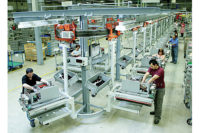Honda Aircraft Co.'s new facility has been designed to allow assemblers to “maximize their efforts under the safest possible conditions.”
Honda Aircraft Co., a division of Honda Motor Co., hopes to revolutionize the business jet market with its six-passenger HondaJet. The aircraft features a number of innovations, such as an over-the-wing engine mount configuration, which frees up additional space for fuel. It’s also equipped with an all-composite fuselage to reduce weight and increase fuel efficiency.
The company recently opened a state-of-the-art factory in Greensboro, NC, to assemble the HondaJet. The 150,000-square-foot facility has been designed to provide an environment within which assemblers can “maximize their efforts under the safest possible conditions.”
For example, in-floor utility boxes at each assembly station strategically place electricity and compressed air power for production tools. “That eliminates the need for long hoses and power cords run over the production floor from the more traditional wall-mounted outlets,” says Michimasa Fujino, president and CEO of Honda Aircraft Co.
“This design feature allows the free movement of aircraft down the assembly line without the need to move other workstation cables, thereby reducing the interference to each workstation from the free flow of aircraft along the line,” adds Fujino. “Minimizing the use of intrusive hoses and power cords also creates a safer working environment for production associates.”
The new facility also features an extremely clean, white floor, which enhances illumination to help improve both overall visibility and the assembler productivity. The brighter working environment uses less electricity.
“As at other Honda manufacturing facilities, we will have point-of-use materials at each workstation,” Fujino points out. “[Assemblers] will be provided everything they need in order to achieve first-time quality, while minimizing waste.
“In addition, the integrated nature of the production facility is also very similar to that of other Honda facilities, where all aspects of assembly and finishing, as well as final quality checks, are conducted in a single facility,” adds Fujino. “By maintaining an integrated assembly environment, any issue that is identified during the assembly process can be immediately identified and rectified by the appropriate assembly associates from anywhere within the facility.”
The production team is involved in setting up each workstation and they are working together to establish a productive and ergonomic work environment for the assembly processes. “Technicians assist with setting up the areas and simplifying the work instructions,” explains Fujino. “Integrated teams also are developing integrated assembly tools that have all the required materials and support equipment on the production tooling.
“Ongoing, there will be integrated work teams that will continue to identify quality and continuous improvement items to further reduce waste,” adds Fujino. “These teams will be responsible for identifying and implementing actions to resolve issues and further increase efficiency and performance.”
Get our new eMagazine delivered to your inbox every month.
Stay in the know on the latest assembly trends.
SUBSCRIBE TODAY!Copyright ©2024. All Rights Reserved BNP Media.
Design, CMS, Hosting & Web Development :: ePublishing


